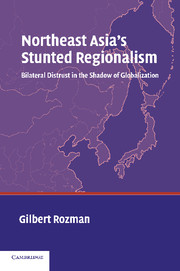Book contents
- Frontmatter
- Contents
- Acknowledgments
- Map
- Northeast Asia's Stunted Regionalism
- 1 Introduction: The Challenge of the Northeast Asia Region
- 2 Exiting the 1980s: Cold War Logic and National Aspirations
- 3 1991–1993: Border Fever and Cross-Border Duplicity
- 4 1994–1996: Civilizational Bridges and Historical Distrust
- 5 1997–1998: Strategic Partnerships and National Rivalries
- 6 1999–2000: Sunshine Policy and Security Dilemmas
- 7 2001–2003: Unilateralism and Irrepressible Regionalism
- 8 Conclusion: Lessons for Constructing Regionalism in Northeast Asia
- Index
4 - 1994–1996: Civilizational Bridges and Historical Distrust
Published online by Cambridge University Press: 18 December 2009
- Frontmatter
- Contents
- Acknowledgments
- Map
- Northeast Asia's Stunted Regionalism
- 1 Introduction: The Challenge of the Northeast Asia Region
- 2 Exiting the 1980s: Cold War Logic and National Aspirations
- 3 1991–1993: Border Fever and Cross-Border Duplicity
- 4 1994–1996: Civilizational Bridges and Historical Distrust
- 5 1997–1998: Strategic Partnerships and National Rivalries
- 6 1999–2000: Sunshine Policy and Security Dilemmas
- 7 2001–2003: Unilateralism and Irrepressible Regionalism
- 8 Conclusion: Lessons for Constructing Regionalism in Northeast Asia
- Index
Summary
The year 1993 ended with the Seattle APEC summit, the first occasion when the leaders of this organization established in 1989 met to set an agenda for cooperation. This upgraded meeting conveyed the unmistakable message that a more robust organization was sought, but for what purpose? The balance between regionalism and globalization was at stake. On the one hand, Mahathir Mohammad of Malaysia had advocated creation of the EAEC to exclude non-Asians, notably all nations with white Anglo-Saxon majorities. If initially this idea had been rejected, it still resonated in some circles and talk of some sort of regional entity in NEA or together with SEA persisted. On the other hand, Bill Clinton had invited the leaders to Seattle to further institutionalize their activities within a global context, seeking a commitment to reduce trade barriers and new financial openness consistent with the U.S. global agenda. After all, the United States had greeted APEC as a mechanism for placing trans-Pacific interests over Asian ones, and in the uncertainty of 1993 after the euphoria of 1991–2 this goal required reinforcement.
In the background a transnational discussion of Samuel Huntington's provocative warning about an emerging “clash of civilizations” helped to place issues of regionalism in a context of questions of cultural disposition toward the role of the state, the place of the market, and the degree of openness to foreign ideas.
- Type
- Chapter
- Information
- Northeast Asia's Stunted RegionalismBilateral Distrust in the Shadow of Globalization, pp. 127 - 173Publisher: Cambridge University PressPrint publication year: 2004



